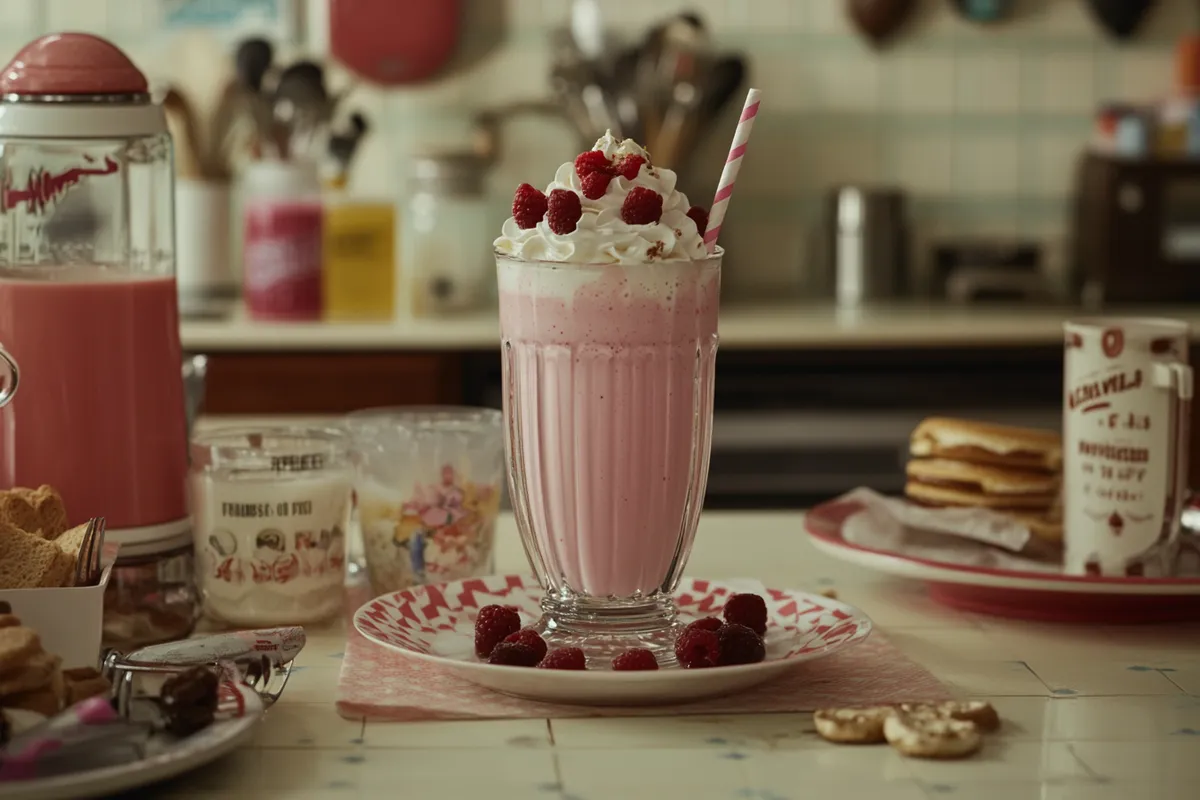Introduction
Why is a Milkshake Called a Milkshake? When you enjoy a milkshake, you’re sipping on a sweet, creamy treat with a fascinating history. The name itself reflects its transformation from a simple medicinal drink into a beloved indulgence.
In this article, we’ll explore the milkshake’s origins, the meaning behind its name, and how it has evolved over time. We’ll also delve into why it continues to be a pop culture icon worldwide. Let’s uncover the story behind this classic drink and what makes it so special.
Milkshakes Overview
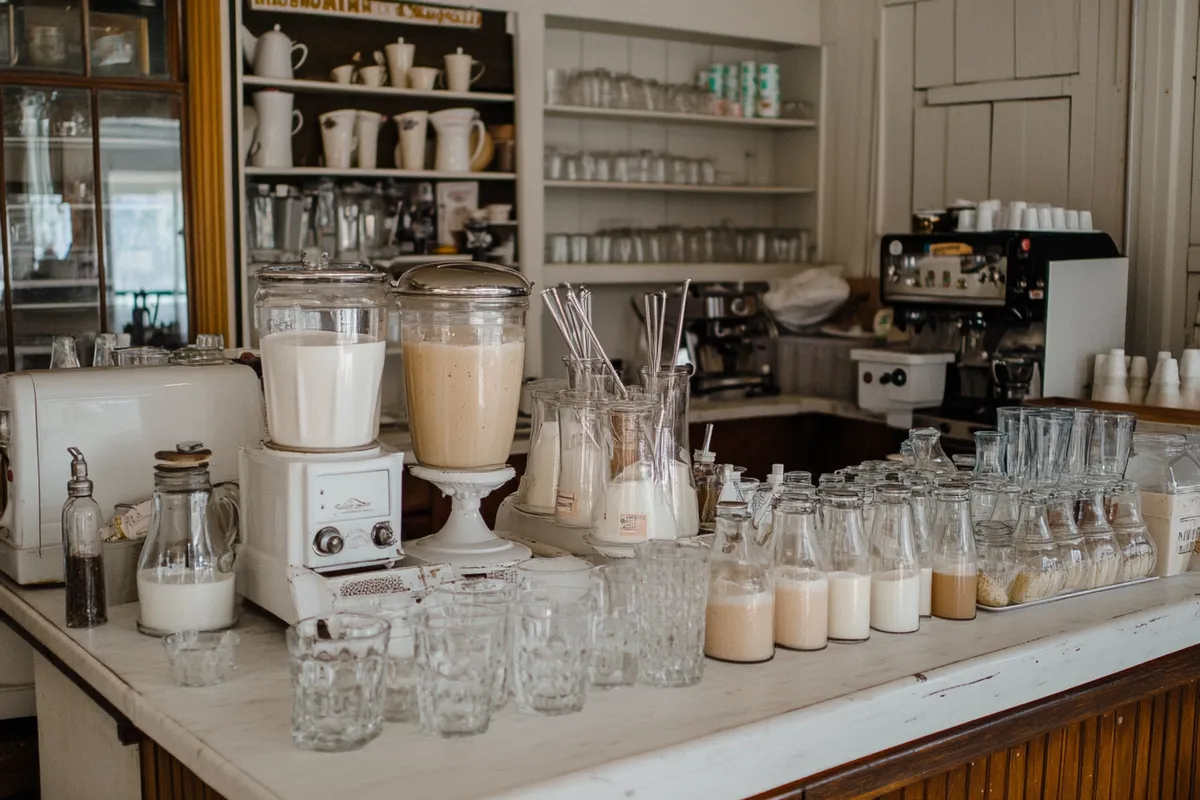
What Is a Milkshake?
A milkshake—whether classic vanilla, rich chocolate, or trendy salted caramel—symbolizes indulgence and comfort. It blends milk, ice cream, and flavorings into a creamy, smooth treat that satisfies any sweet craving.
But a milkshake is more than its ingredients. It’s an experience. From enjoying a frosty shake on a hot day to reliving diner nostalgia, milkshakes offer pure joy. While simple in makeup, their name carries a rich history spanning centuries. Over time, milkshakes evolved into more than just drinks—they became cultural icons, starring in movies, TV shows, and social media trends.
Early History of the Milkshake
The milkshake’s history connects closely to the rise of soda fountains in the late 19th and early 20th centuries. Back then, the milkshake was nothing like the sweet, ice cream-laden treat we know today. In its earliest form, milkshakes were more of a medicinal drink, often mixed with eggnog, a type of spiced milk drink, to soothe the stomach or as a quick source of calories for people with poor appetites. Imagine a glass of milk with added eggs, sugar, and maybe a little bit of flavoring—definitely not the creamy, sugary beverage we enjoy at diners today.
The first mentions of the term “milkshake” date back to the early 1900s. People promoted it as a health tonic. Pharmacies and soda fountains sold milkshakes, claiming they had therapeutic effects.
Early milkshakes were like protein shakes but with more sugar and flavor.They didn’t blend the ingredients; instead, the “shake” in the name referred to stirring them by hand.
How Did Milkshakes Evolve Over Time?
The transition from medicinal drinks to the sweet, indulgent shakes we know today was gradual but significant. As soda fountains gained popularity in the early 20th century, milkshakes began to evolve into a more refined, dessert-like drink. The rise of ice cream as a popular treat was a major turning point. Ice cream’s richness and texture, when combined with milk, helped create the smooth and creamy consistency that people now associate with milkshakes.
By the 1920s, milkshakes were gaining traction as a treat rather than a medicinal beverage. Soda fountains across the U.S. offered milkshakes in flavors like vanilla, chocolate, and strawberry and customized them to suit individual tastes. But it wasn’t until the 1930s, with the invention of the milkshake machine, that milkshakes really took off in the public imagination. These machines made it easier to blend ice cream and milk, speeding up the process and allowing for even greater consistency in texture. They also allowed diners to serve milkshakes on a larger scale, further cementing the drink’s place in American dining culture.
The Role of Milk in a Milkshake’s Name
So, where does the term “milkshake” come from, and how does it tie into the ingredients? The name actually makes a lot of sense when you look at it from a historical perspective. In the early days, milk was the core ingredient. It was essential for the drink, providing the base for both texture and taste. The “shake” part of the name refers to stirring or shaking the ingredients, though in its early days, people didn’t shake milkshakes in the way we think of today. However, the term stuck, and as the drink became smoother and creamier, the name milkshake fit perfectly.
In essence, a milkshake is exactly what it sounds like—a shake made with milk. But, over time, as the drink evolved, the inclusion of ice cream and flavorings helped give it the name we know today. The name “milkshake” perfectly captures the beverage’s essence: a mix of milk, cream, and a shake that gives it that frothy, fun texture we love.
Why is a Milkshake Called a Milkshake?
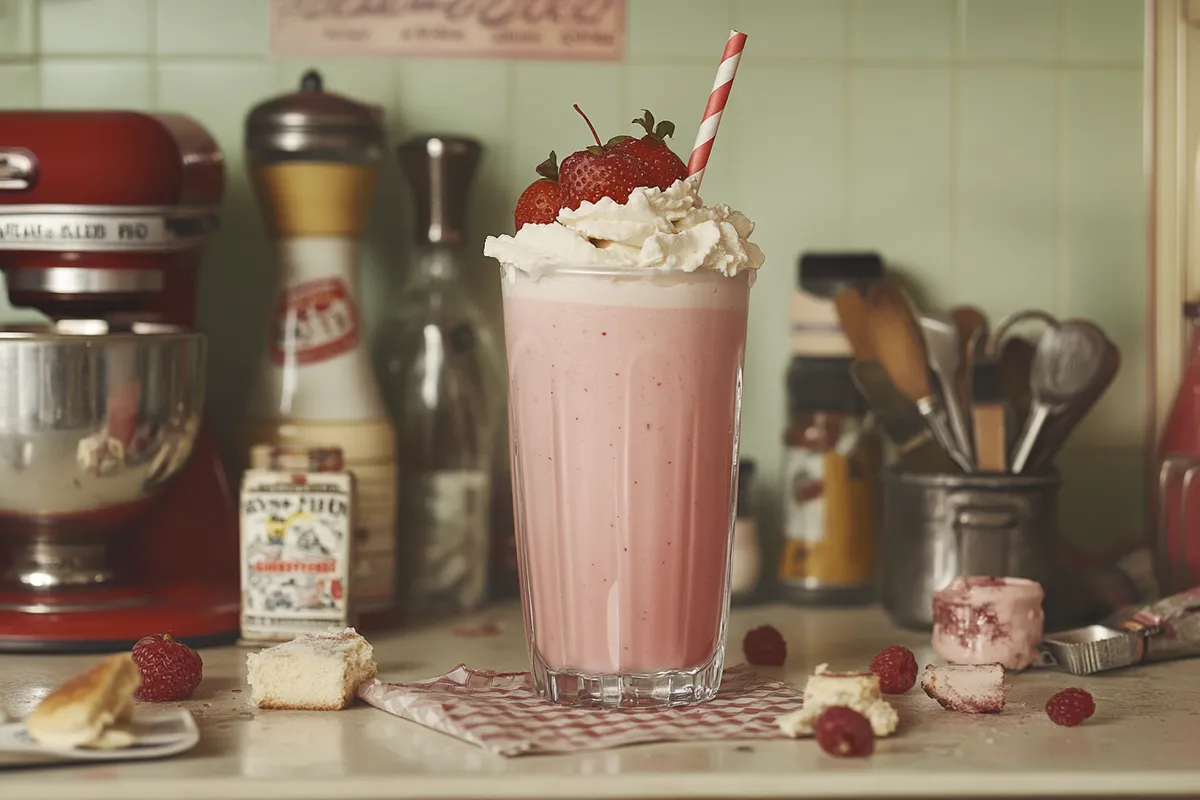
The Origin of the Term ‘Milkshake’
The term “milkshake” has a curious and somewhat mysterious origin. It first appeared in the late 19th century. Early milkshakes weren’t the sweet desserts we know today. Instead, they were more like medicinal drinks made with milk, eggs, and other soothing ingredients. Soda fountains and pharmacies often served them as energy boosters and quick nourishment.
In the beginning, people called these drinks “egg nog” or “egg milkshake” because eggs were a key ingredient. This was long before ice cream and sugar became staples. As the drink evolved, the name shifted to “milkshake,” highlighting milk as the main ingredient. By the 1900s, “milkshake” became the standard name, reflecting its growing popularity as a flavorful, indulgent treat rather than a medicinal tonic.
Evolution of the Term from “Eggnog” to “Milkshake”
In the early 20th century, the term “milkshake” began to gain traction, replacing older terms like “eggnog” or “egg milkshake.” This shift reflected not only the changing ingredients of the drink but also its evolving cultural significance. Eggnog referred to a drink made primarily from milk, eggs, and spices, but milkshakes distinguished themselves with their smoother texture and the addition of ice cream.
In its original form, a milkshake was essentially a thickened version of eggnog. As ice cream became more popular and affordable, it replaced eggs in the recipe, making milkshakes creamier and richer. This transition in ingredients paved the way for the name “milkshake” to become synonymous with a smooth, creamy dessert drink. Today, when we refer to a milkshake, we think of it as a drink that’s more indulgent and dessert-like than its original, medicinal predecessors.
How the Word ‘Shake’ Came to Symbolize Mixing
The “shake” in “milkshake” is just as key as the milk. It originally referred to shaking ingredients by hand. Before electric milkshake machines, people mixed milkshakes manually, stirring or shaking to get a smooth texture. That’s how the drink got its name.
The word “shake” doesn’t mean the drink must be cold or have ice cream. While most milkshakes today are frozen, “shake” simply describes the mixing process. Over time, the term became linked to the creamy texture. Even now, when you order a milkshake at a diner, you’re enjoying that original “shake”—a perfectly mixed, frothy drink.
Cultural Significance of the Milkshake Name
The name milkshake isn’t just a description of the drink—it carries cultural and historical weight. Throughout the 20th century, milkshakes became an iconic part of American dining culture, particularly in the rise of soda fountains and diners in the 1930s and 1940s. Milkshakes weren’t just popular because they tasted good; they were also a symbol of leisure, youth, and socializing. The image of a milkshake—often served in a tall glass with a cherry on top and sometimes accompanied by a straw—became inseparable from the idea of American nostalgia and diner culture.
The name itself reflects a kind of comfort and familiarity, evoking images of diners, malt shops, and gatherings with friends or family. The simplicity of the name—milk plus shake—also underscores its unpretentious nature. Unlike other drinks that may require more elaborate names or explanations, a milkshake is straightforward and easily understood by everyone. The drink uses milk and achieves a smooth, creamy consistency through shaking or blending.
Milk defined the milkshake’s identity, showcasing its essential and nourishing qualities. Early milkshakes promoted milk’s health benefits and marketed it as a nutritious drink. Marketers especially recommended them for people seeking extra calories or improved appetites.
This focus on health helped milk become a key ingredient in milkshakes. Even now, milk or dairy substitutes are central to what defines a milkshake.
Milkshake vs. Other Similar Beverages
The milkshake isn’t the only creamy beverage out there. There are many drinks that share similarities, but what makes a milkshake stand apart? For one, a milkshake typically features ice cream as a key ingredient, giving it that indulgent, dessert-like quality. The presence of milk is a defining feature too—other beverages like smoothies or frappes don’t always contain milk or have the same consistency.
A smoothie, for instance, is often made with fruit, yogurt, or juice, and doesn’t include ice cream. It’s generally thicker and more nutritious, but not as sweet or indulgent as a milkshake. Similarly, a frappe, which is more common in New England, is made with ice cream and flavored syrups but is generally a bit lighter than a traditional milkshake and less creamy in texture.
What sets the milkshake apart from these other beverages is its rich, thick texture, which is usually a result of both milk and ice cream. The word “milkshake” conveys the idea of a dessert drink, whereas smoothies and frappes may not always have that indulgent or sweet connotation. Historically, naming conventions helped solidify the milkshake’s identity as a sweet, creamy treat—a product of its ingredients (milk and ice cream) and the mixing process.
The Role of Milk and Milkshake Machines
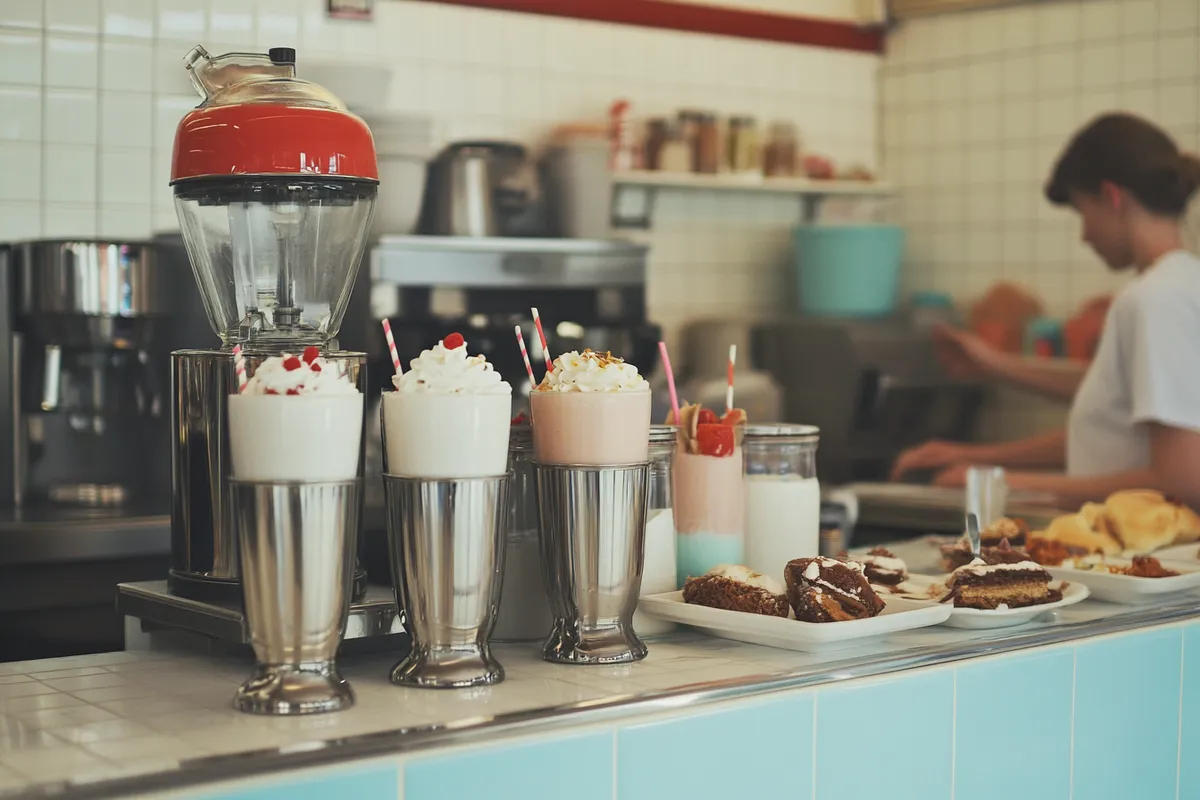
Milk as the Core Ingredient
Milk has long been the heart and soul of a milkshake. But what made it the essential ingredient in this beloved treat? To understand the role of milk in milkshakes, we must look at both the nutritional and cultural significance of milk in early 1900s America.
At the time, milk was a staple in households across the nation. It wasn’t just a source of nourishment for children; it was also viewed as a quick, inexpensive, and healthy way to get essential nutrients, especially calcium and protein. People looked to milk for both its health benefits and its versatility. In the case of milkshakes, it was the milk’s rich, creamy texture that provided the drink with its smooth, velvety consistency.
Milk’s role was twofold: it not only gave milkshakes their nutritional backbone, but it also helped them achieve that signature creamy texture. Without milk, milkshakes would have been far thinner and less indulgent. The addition of ice cream to the mix made the drink even thicker, but milk was always the base. This made it possible for milkshakes to achieve the right consistency—rich but drinkable. In essence, milk didn’t just contribute to the taste; it defined what a milkshake was.
In a time when processed foods were becoming more common, milk was still a relatively pure ingredient. It was seen as natural and wholesome, which contributed to the drink’s cultural popularity. Early milkshakes were marketed as a healthful option, with advertisements focusing on the nutritional benefits of milk. It wasn’t just a sweet indulgence—it was something that could be part of a healthy diet.
The Birth of the Milkshake Machine
The invention of the milkshake machine in the 1930s was a game-changer. Before the machine, making milkshakes required a great deal of manual effort. Milk, ice cream, and flavorings were combined by hand or using rudimentary equipment. This process could take quite a bit of time, and consistency varied from one shake to the next.
Then came Jim E. Sutherland, the inventor behind the first commercial milkshake machine. In 1936, Sutherland patented a machine that could blend ingredients quickly and efficiently, giving diners a smoother, more consistent milkshake. The impact of this machine was far-reaching. Not only did it streamline the process, but it also allowed for quicker service and better consistency in flavor and texture. The new machine could mix the ice cream and milk more evenly, producing a frothy and creamy result every time.
With the introduction of the milkshake machine, the beverage industry saw significant changes. Diners, soda fountains, and fast-food chains were able to produce milkshakes on a larger scale and with greater efficiency. This was an important milestone in the development of the milkshake as a mainstream drink. It helped to democratize the milkshake, making it more accessible to the masses and contributing to its cultural rise. Suddenly, you didn’t have to be a skilled mixologist or a soda fountain expert to make a great milkshake; the machine did most of the work.
Key Milestones in the Development of Milkshake Machines
From the 1930s to today, milkshake machines have undergone several important innovations. The first machines were manual or semi-automatic, and they were often found in soda fountains and diners. Over time, these machines became more sophisticated, with advancements that allowed for better mixing, faster service, and more precise control over the texture and temperature of the shakes.
In the 1950s, electric milkshake machines became common, making milkshakes faster and more consistent. By the 1960s, multi-spindle machines allowed diners to blend several shakes at once. These machines helped busy spots handle large orders during peak hours.
Today, milkshake machines continue to improve. Modern models can mix ice cream and non-dairy options to meet changing customer needs. They handle more flavors and toppings, like fruits, syrups, and candy, making custom milkshakes easier than ever.
How Milkshake Machines Changed the Way Milkshakes Were Made and Consumed
The milkshake machine changed how people enjoyed milkshakes. Before its invention, milkshakes were made by hand, often inconsistently. The machine allowed milkshakes to be mass-produced quickly and with uniform quality. It blended ingredients smoothly, eliminating lumps and uneven textures.
As milkshake machines spread, milkshakes became a staple in fast-food spots and diners. They shifted from a rare treat to an everyday indulgence. The machine’s efficiency made milkshakes easy to prepare and widely available, helping them gain mainstream popularity. Today, milkshakes are both a delicious dessert and a symbol of dining convenience.
Modern Milkshake Trends
Milkshake machines are now essential in fast-food spots, cafes, and restaurants. They define the milkshake experience by ensuring consistency. Chains like McDonald’s, Shake Shack, and Five Guys depend on these machines to make high-quality shakes quickly and easily.
Technology has brought new milkshake trends. Modern machines allow for varied textures and flavors, including non-dairy shakes using almond, oat, or coconut milk. Restaurants now cater to dietary needs and preferences. Over-the-top creations like freakshakes, loaded with toppings, have also become popular. Social media drives this trend, with influencers sharing colorful, photogenic milkshakes topped with cookies, sprinkles, or syrups.
Milkshakes have become more than a drink—they’re an experience. Platforms like Instagram have made them a favorite for food lovers. With layers of whipped cream and vibrant designs, today’s milkshakes are far from the simple drinks of the past.
FAQs Section
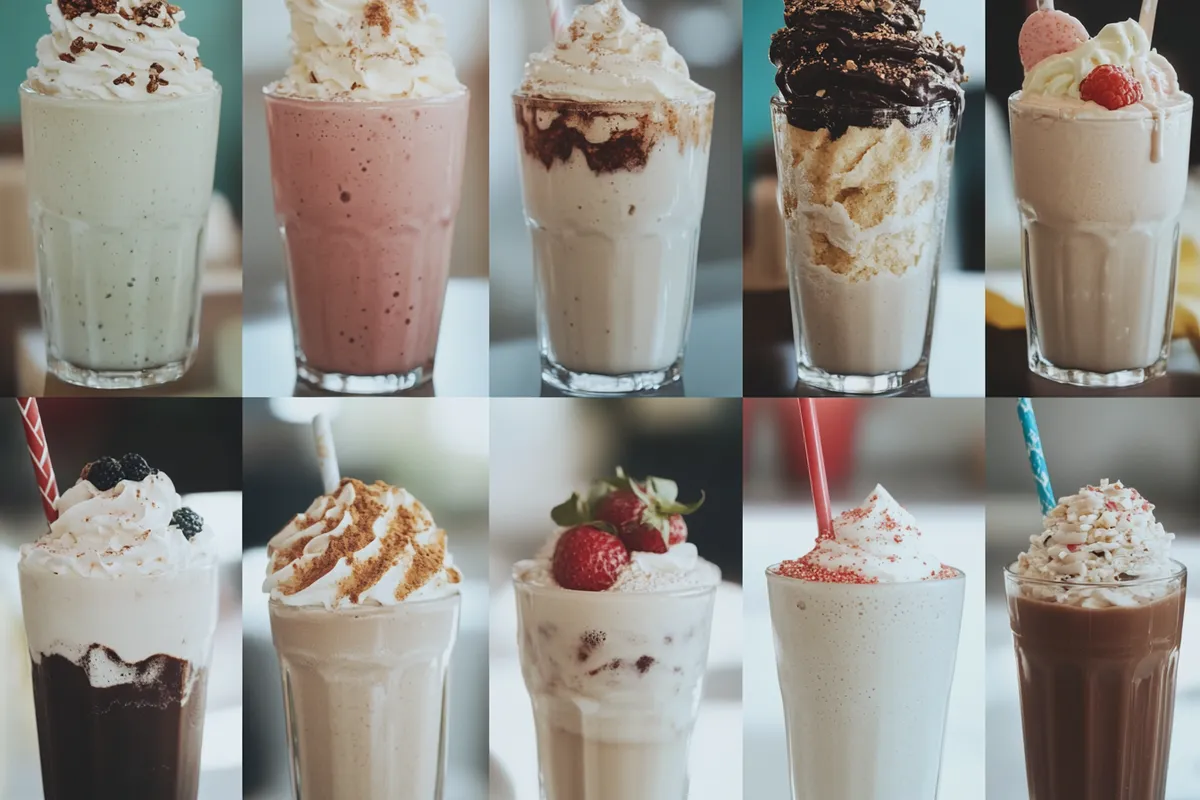
Milkshakes and frappes seem similar, but they aren’t the same. Milkshakes usually combine milk and ice cream for a thick drink. Frappes, especially in New England, often use ice cream and flavored syrups but have a thinner consistency. In some areas, people call a blend of milk and ice cream a frappe if it’s not as thick as a traditional milkshake.
What makes a milkshake different from a smoothie?
The main difference between a milkshake and a smoothie lies in their ingredients and texture. A milkshake is made with milk and ice cream, giving it a creamy, indulgent texture. A smoothie, on the other hand, typically includes fruit, vegetables, yogurt, or juice, and is often healthier and thicker but not as sweet or rich as a milkshake.
What was the original recipe for a milkshake?
The original recipe for a milkshake was quite different from today’s creamy version. Early milkshakes in the 1900s were more like a medicinal drink, typically made with milk, eggnog, sugar, and spices. These shakes were sold in pharmacies as tonics to boost energy and were not made with ice cream until later.
Can you make a milkshake without ice cream?
Yes, it’s possible to make a milkshake without ice cream. You can substitute with frozen yogurt, custard, or even non-dairy options like almond or coconut milk. While these variations won’t be as creamy, they can still deliver that smooth, thick texture and rich flavor.
Were milkshakes ever shaken?
Early milkshakes were shaken, not blended. Before milkshake machines, people mixed milk, eggnog, and flavorings by hand. They shook the ingredients in a glass to create a smooth texture. The name “milkshake” comes from this shaking process.
Why can’t McDonald’s call their shakes milkshakes?
McDonald’s doesn’t call their shakes “milkshakes” in some areas because of a legal issue with the ingredients. Their shakes use different ingredients, like artificial flavorings, that don’t meet traditional milkshake standards. That’s why McDonald’s simply calls them “shakes.”
What is the origin of the word milkshake?
The term “milkshake” originated in the early 1900s when the drink was first popularized. It was a combination of milk and shaking, as early milkshakes were made by shaking milk, eggs, and flavors together. Over time, the word evolved as the drink became more dessert-like, with the inclusion of ice cream and sweeter flavors.
What makes a milkshake a milkshake?
Milk and ice cream define a milkshake, blending together to create a thick and creamy treat. The key factors that make it a milkshake are its creamy consistency, the presence of milk as a base, and the ability to blend milk with ice cream or non-dairy substitutes. The “shake” in the name refers to the mixing or blending process that creates the iconic smooth, frothy texture.
Conclusion
Milkshakes have come a long way since their start as a medicinal drink in the early 1900s. People originally made milkshakes with milk, eggs, and spices to soothe the stomach and provide nourishment. Over time, milkshakes transformed into creamy, indulgent desserts loved worldwide. The invention of the milkshake machine made them faster to prepare and more consistent, while the rise of ice cream turned them into a nostalgic treat.
Today, milkshakes are more than just a drink—they’re a cultural icon. Featured in movies, shared on social media, and served in trendy bars, they symbolize indulgence and comfort. Modern milkshakes continue to evolve, with non-dairy options and extravagant creations showing their lasting appeal in a changing world.
So, why is a milkshake called a milkshake? It’s simple: the name reflects its core ingredients—milk and the shaking process that blends everything together. Today, the milkshake’s rich history continues to impact how we enjoy this iconic drink, blending tradition with modern creativity.

